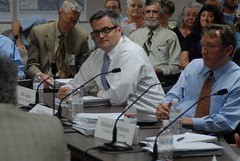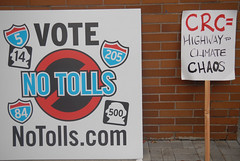A key group of elected officials and transportation bigwigs from Oregon and Washington convened this morning and agreed to adopt a major set of recommendations that will move the Columbia River Crossing project forward. The Project Sponsors Council unanimously agreed to push ahead on a 10-lane bridge and also agreed on significant changes to the Hayden Island interchange.
With Portland Mayor Sam Adams and Metro President David Bragdon saying they support a 10-lane bridge and a recent report by the Independent Review Panel calling for something to be done “sooner than later,” momentum seems to be surging for the project. But while Project Sponsors Council members congratulated each other today for making headway and healing some of the wounds of controversy that have plagued the project in the past, a coalition of environmental, public health, and bicycling advocates issued a statement making it clear they are still not happy with the direction of the project.
“… the current proposal would create congestion in the Rose Quarter and I-205, increase global warming pollution from cars and trucks, worsen air quality, and decrease bicycle and pedestrian safety.”
— From a statement signed by the BTA and other transportation and health advocacy groups
In a statement, the coalition — which includes the Bicycle Transportation Alliance — says the CRC “megaproject” is “overly expensive and completely out of line with Oregon’s vision for reducing greenhouse gas emissions.”
At today’s meeting, BTA advocacy manager Gerik Kransky sat in the crowd and listened to experts rattle off a host of benefits that would come with building a new 10-12 lane bridge.
Counter to what the BTA and other land-use and health groups have been saying for years, a recent modeling exercise done by Metro showed that building a 12-lane bridge with light rail and a $2 peak-period toll would not result in sprawl. (With tolls, the study found that Clark County would have a negligible increase in household growth compared to 0.7% growth without tolls.)
Katy Brooks from the Port of Portland shared details on an analysis of travel times and number of accidents with and without a new bridge. Currently, traveling north during the evening commute from the Morrison Bridge exit in Portland to 99th Street in Vancouver would take over 45 minutes. With a new 10-12 bridge, by 2030, the estimated travel time would be around 20 minutes — less than half of what it is today. Brooks also said that, given expected growth, there would be about 750 crashes along the project corridor by 2030 if no new bridge was built, but with a new bridge that number would drop to just 240 crashes.
After hearing these numbers and despite Mayor Adams supporting a 10-lane bridge, the BTA remains unconvinced that it’s necessary. The BTA’s Kranksy wrote via Twitter during the meeting that while he appreciates Adams’ desire for a smaller bridge, “a 10-lane permanent bridge is still massive.” (Note: Adams has said he’s still interested in discussing an 8-lane option, but hasn’t had time to do the full analysis.)
As momentum builds around the project, the BTA will have to lobby and build resistance from outside the process. Last August, former BTA staffer Michelle Poyourow decided to walk away from the project after feeling their concerns were not being taken seriously. Kransky told me today they have no intention of officially re-engaging with the project and that they’ll be looking to publish op-eds in The Oregonian and issue a more detailed position statement later this month.
The BTA and other advocacy groups will have plenty of time to mount their campaigns against the current direction of the CRC. While there was significant progress and agreement at the meeting today, major hurdles — such as binding decisions on the bridge’s design, how it will be governed and who will pick up the estimated $3.6 billion tab — remain elusive.
— Read our past CRC coverage here.



